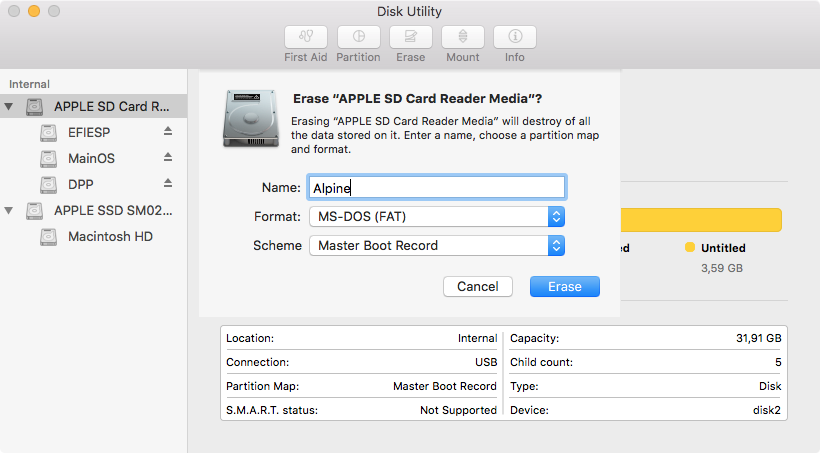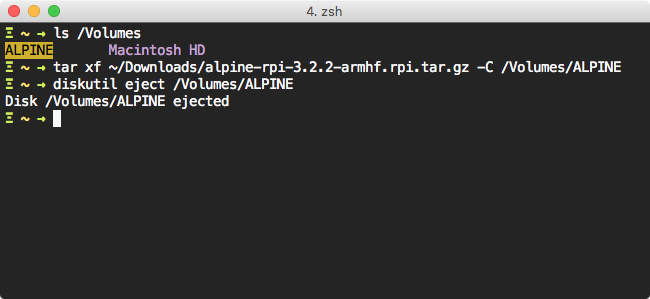Create a bootable SDHC from a Mac: Difference between revisions
(Guide to creating a bootable Raspberry Pi Alpine Linux installation using a Mac) |
m (Added warning for MacOS users that are not running an old version of MacOS.) |
||
| (11 intermediate revisions by 8 users not shown) | |||
| Line 1: | Line 1: | ||
== Prepare Partition == | |||
Newer versions of MacOS does not allow you to set scheme. Creating MBR using fdisk will result in a disk that MacOS cannot mount. This instructions are out of date for newer versions of MacOS. | |||
[[File:OSXRpiSetupDiskUtility.png]] | |||
* Open disk utility | |||
( | * Select your SD Card | ||
sudo | * Click Erase in the menu | ||
* Set Format to MS-DOS (FAT) | |||
* Set Scheme to Master Boot Record | |||
* Click the Erase button | |||
== Unpack files == | |||
[[File:OSXRpiSetupTerminal.png]] | |||
* Open Terminal | |||
* Check your SD Card is mounted (in this case named "ALPINE") | |||
* Unpack files with <code>sudo tar xf ~/Downloads/alpine-rpi-[...]-armhf.rpi.tar.gz -C /Volumes/ALPINE</code> | |||
* Eject disk, it should now be ready to be used in the Raspberry Pi | |||
== After initial setup == | |||
After this preparation you should boot the Raspberry Pi with a keyboard and a HDMI screen connected, login as root and run <code>setup-alpine</code> and <code>lbu-commit</code>. | |||
[[Category:Installation]] | |||
Latest revision as of 17:50, 18 October 2023
Prepare Partition
Newer versions of MacOS does not allow you to set scheme. Creating MBR using fdisk will result in a disk that MacOS cannot mount. This instructions are out of date for newer versions of MacOS.
- Open disk utility
- Select your SD Card
- Click Erase in the menu
- Set Format to MS-DOS (FAT)
- Set Scheme to Master Boot Record
- Click the Erase button
Unpack files
- Open Terminal
- Check your SD Card is mounted (in this case named "ALPINE")
- Unpack files with
sudo tar xf ~/Downloads/alpine-rpi-[...]-armhf.rpi.tar.gz -C /Volumes/ALPINE - Eject disk, it should now be ready to be used in the Raspberry Pi
After initial setup
After this preparation you should boot the Raspberry Pi with a keyboard and a HDMI screen connected, login as root and run setup-alpine and lbu-commit.

